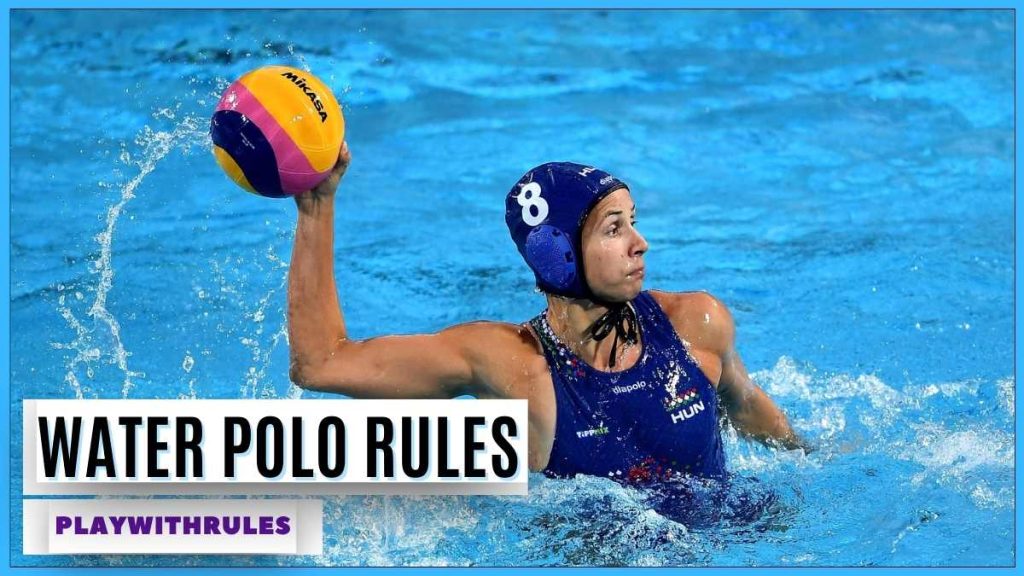Water Polo Rules: Did you know that Water Polo is widely considered to be one of the most physically demanding sports in the modern sports catalog? Although at first glance it might seem all ‘fun and frolic,’ having incredible stamina, endurance, swimming, and precision are non-negotiables in the game. You have to use a combination of strategy, teamwork, and a great deal of individual skill and creative thinking to win at a professional Water Polo game.
Although it is an Olympic sport, not too many people are familiar with the rules of water polo. Today, we are going to change that by taking a comprehensive and structured approach to learn the ropes—how to score, how to win, what the different kinds of fouls are, etc.- along with a couple of interesting facts about this wonderful game. Let’s begin!
Table of Contents
How To Play Water Polo?
Two teams of 7 players each compete against each other in Water Polo. A goalkeeper defends each team’s goal, and the rest of the players swim with the ball, dribble, and pass amongst themselves to try and score a goal. However, you cannot shoot from anywhere in the pool – there are designated areas and rules of water polo that you have to follow. In this article, we will unravel many such rules associated with this game. So, read on to learn more about them.
Objective
The objective here is to win by scoring as many goals as possible and defending as many opposition advances as possible. Teams are expected to put on a great game by mixing it up—passing, shooting, and more—so both teams must have their own tactics to out-maneuver their opponent. However, if you are playing it casually, make sure you do not forget the secondary objective—have heaps of fun!
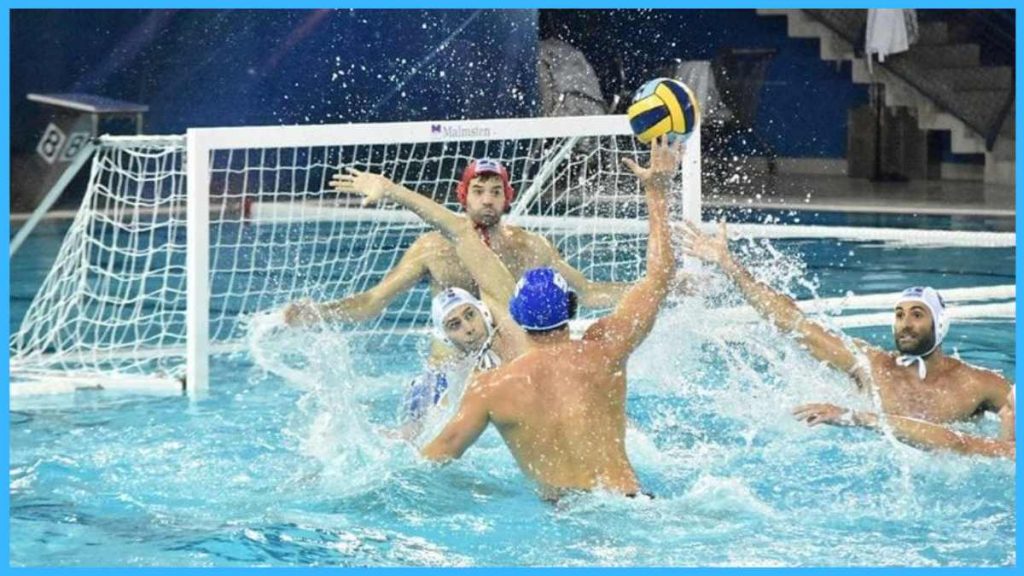
Water Polo Rules
It doesn’t take much to figure out how to play Water Polo – the game mechanics are simple, and if you have played soccer and basketball, you will get the hang of it quickly. That being said, Water Polo has specific rules that must be followed at all times. So what are you waiting for? Let’s take a look at Water Polo rules.
General Rules of water polo
The water polo rules refer to the rules that dictate how the game should be played, for how long, etc. Let’s dive in:
- The game starts with both teams in their respective halves of the pool. The ball stays on the midline (explained later). When the referee signals for the game, players from both ends start swimming towards the ball. The first player to secure the ball or pass to a teammate wins the ball for their side.
- According to Water Polo Rules, Each team comprises 7 players – 1 goalie and 6 players who pass and score goals.
- Players can use only one hand to navigate, pass, or shoot the ball. Only goalies or goalkeepers are allowed to use both hands to defend the goal while they are within 5m of it.
- A typical water polo game lasts for about four quarters. Each quarter lasts about 8 minutes, with a 2-minute break between the quarters. To summarise, nearly every water polo game lasts about 32 minutes (excluding the breaks).
- The only way to advance with the ball in Water Polo is by passing it to your teammates or by swimming and dribbling it by pushing it in front of you.
- As per Water Polo Rules, Players are not allowed to dive inside and touch the bottom of the pool. To advance, players can swim for the entire match or tread water.
- Once a team has a ball within the opponent’s goal area, the team has 30 seconds to shoot and try to score a goal.
- A goal carries 1 point. For a throw to be a goal, the ball has to have wholly crossed the goal line and between the goal posts.
- If the scores are tied at the end of the game, a penalty shootout decides the winner.
- Water Polo rules further suggest that players can intercept, block, deflect, and remove opponents from their path to defend and snatch possession from the opponent team.
- The 2m line (red colored line on either side of the pool) has a unique function. According to the rules of water polo, players within the 2m line on the opponent’s side cannot receive a pass. They can either shoot or swim with the ball.
- The 5m line (yellow line on either end of the pool) is also essential. If an opponent player is fouled within this line, they are awarded the ball. However, they cannot directly shoot the ball at goal—they have to pass it to another teammate.
Note: The goalkeeper can use both hands to defend a goal up to the 5m line of his own side/goal. The 5m line is also treated as the line for penalty shots/throws.
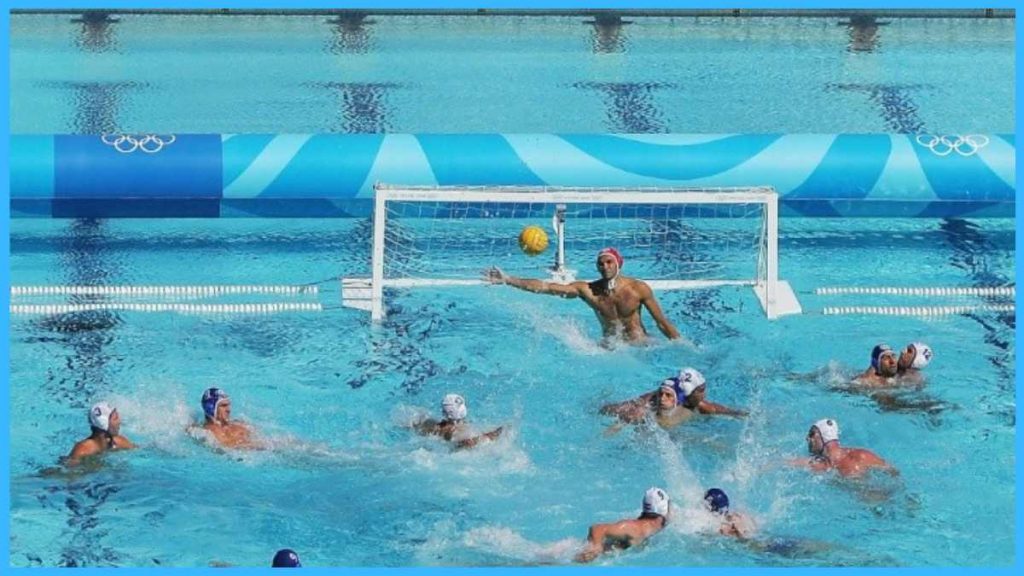
Water Polo Fouls
Given the approach of the game, its tactical, and physical demands of it, fouls are widespread. These fouls can be of different natures – ordinary fouls, major fouls, and brutality. Let’s look at each of these and learn a little more about them.
Ordinary Fouls
Ordinary fouls are less severe infringements carried out in a game. In the case of an ordinary foul, the clock isn’t stopped. Instead, the fouled team is given the possession, and the team committing the foul must allow the opponent to play the ball. However, there is a catch here, even for the fouled team – they have only 3 seconds to play the ball. Otherwise, the possession goes back to the opponent. Some common ordinary fouls are:
- Catching the ball with both hands.
- Taking the ball under the water when being tackled.
- Obstructing or impeding a player when they do not have possession of the ball.
- Pushing a player underwater or holding them underwater when they do not have possession of the ball.
- Pushing off of another player (opponent) to get possession of the ball or to execute a tackle.
- Splashing
- Failure to pass or shoot the ball within 30 seconds of possession.
Major Fouls
Major fouls are more serious. Naturally, the penalty for these is more severe. A player committing a major foul has to exit the game and sit it out for 20 seconds. If a player manages to rack up 3 major fouls in a game, they are automatically excluded from the rest of the game. Here are some common major fouls in Water Polo:
- Hitting, striking, or kicking a player.
- Splashing in the face of an opponent deliberately.
- Hindering, interfering, or impeding a free throw.
- Misbehaving with the referee.
- Ordinary foul but committed during dead time.
- Unnecessary aggression towards opponents (dragging, pulling, pushing, etc.) when they do not have possession of the ball.
- Pushing an opponent or impeding a free throw, penalty, goal throw, etc.
- Persistent and deliberate misdemeanor and use of foul language.
Brutal/Brutality
If a player intentionally tries to injure another player during the game, this is called brutality. In this case, the offending player is immediately removed from the game.
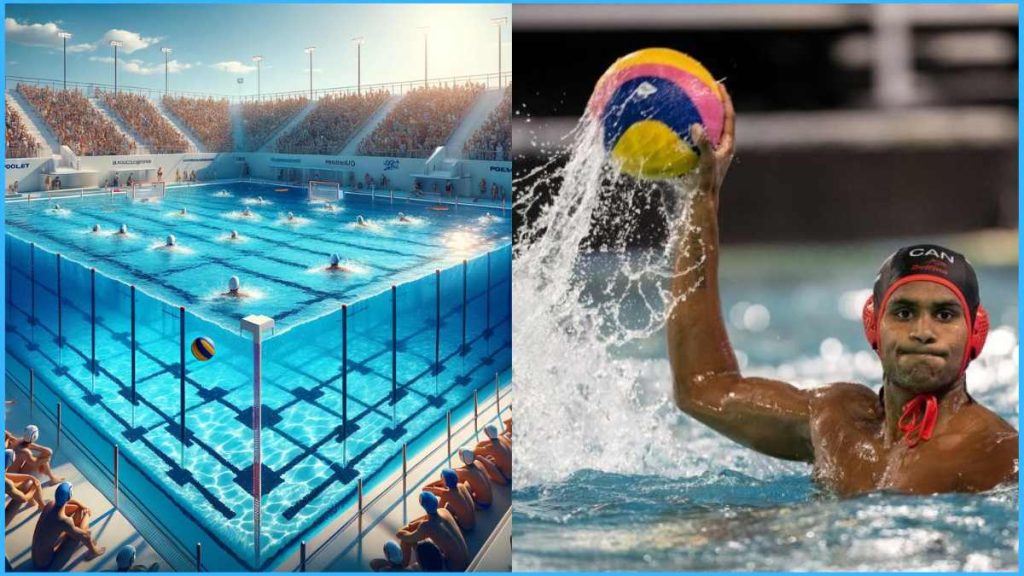
Players & Substitutions
In Water Polo, each team can consist of 7 players (including 1 goalie/goalkeeper). In addition to these active players, each team can have 7 reserves who can be substituted. Substitutions can be made at any point during the game, with the only exception being when the referee awards a penalty. Unless called upon to replace an active player, substitutes are seated on the bench by the side of the pool.
Important Water Polo Terms
Now that you know how to play Water Polo, there are some key terms that you need to know to be able to understand the game to the fullest. Some of them are as follows:
- Penalty – If a player commits a major foul on an opponent who was likely to score a goal or had a fair chance of scoring, then the fouled player is awarded a penalty. In this scenario, the fouled player or any player from that team is awarded a penalty shot from the 5m line. Although no opponent players can impede or intercept, the penalty-taking player must beat the goalkeeper.
- Time-outs—Both teams are allotted time-outs (one minute each) for strategic and tactical purposes. Each team gets one time-out per period of the game.
Scoring
To score a goal, players must coordinate between themselves (passing, forward runs, etc.) to build up a play that eventually turns into a goal. Sometimes, the opponent might interfere, but an uncalled-for interference or foul can lead to a foul or a penalty. This also gives the fouled team a chance at scoring a goal.
Winning
As mentioned earlier, a game of Water Polo lasts for 32 minutes, and the team with the highest number of goals at the end of the stipulated period wins. The objective for each team should be to score more goals than the opponent and define attacks and goal attempts from the opponent team.
Playing Area/ Water Polo Court
The standard pool in which Water Polo is played is usually 30m long, 20m wide, and 2m deep. The red line is 2m away from the goal, and the yellow line is 5m away from the goal. The midline is at the 15m mark (middle of the pool). The goals are 3m wide and 0.9m above the water’s surface.
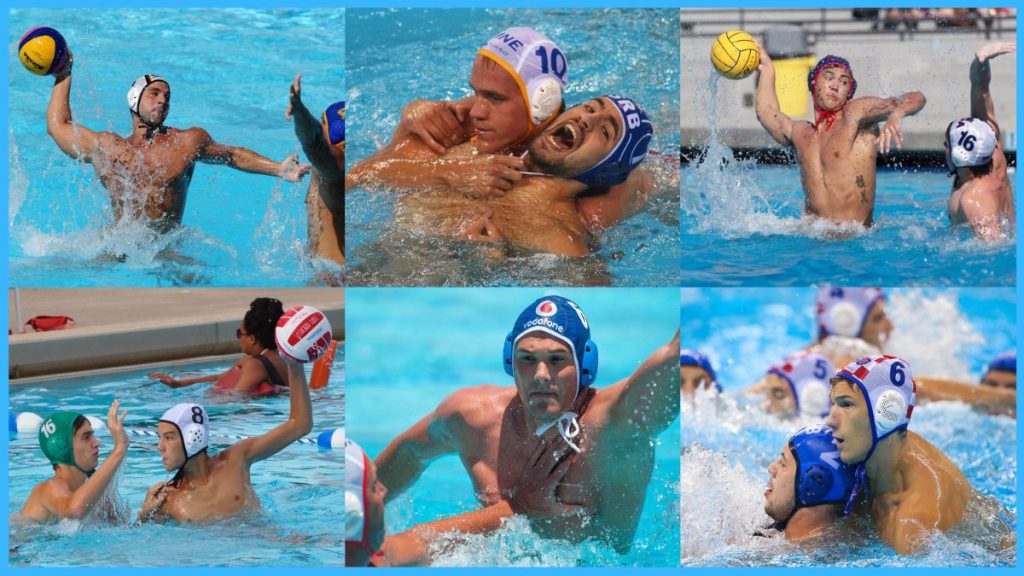
Tips & Strategies
This section of the article will review some constructive tips that can help you improve your Water Polo game exponentially. Make sure you give them a read and try to work on these in your next game:
- Perfect the eggbeater technique—The eggbeater technique is a top-grade swimming technique that many players use to maintain stability in water when upright. In this technique, swimmers kick their legs alternatively (alternative breaststroke kicks) to prevent themselves from swaying.
- Passing—Passing is quite possibly one of the most critical aspects of the game. Accuracy in passing is difficult to achieve in Water Polo, especially with being in the water and the pressure from the opponents. Practice passing to ensure you can pass to where your teammates will be instead of where they are.
- Feints—A trick that works wonders in nearly all sports is feinting. Feinting or faking, if executed precisely, will clear out a path for you to advance or make a pass. It’s an effective technique that can be used anywhere in the game.
- Shooting Arsenal – Expanding your shooting arsenal will make you a great asset to the team. Sometimes, the straight shot from the shoulder might not be the best way. Having deceptive and skillful shooting techniques will help you score goals when most others cannot. Practice lob shots, skip shots, quick releases, etc., to make yourself and your team more diverse.
- Develop codenames – Strategies can change in the middle of a game, and a team that knows how to adapt will always have a much higher chance of winning. One trick that works wonders is to develop codenames and keywords that only your teammates know. This will allow you to communicate plays and strategies to your teammates in the middle of the game without the opponent players getting wind of anything.
Did You Know?
- The game of Water Polo originated in Britain in the mid-19th century. It was popularly described as ‘water rugby.’
- The first official rules of Water Polo were formulated by a Scottish gentleman named William Wilson in 1876.
- Initially, every Water Polo game consisted of 6 periods. That was later reduced to the 4-period game format that is followed today.
- The Water Polo ball has a particular texture that allows the players to get a good grip on it in water.
- Men’s Water Polo made an Olympic debut at the Paris Games in 1900. The women’s game was added in 2000 at the Sydney Games.
FAQs
Is Water Polo an Olympic game?
Yes. Water Polo made its Olympic debut in the 1900s at the Paris Olympic Games.
What skills are needed in Water Polo?
In addition to the standard swimming techniques and skills (stamina, endurance, etc.), players need sharp passing, precise shooting, and the ability to play as a team to become good Water Polo players.
What equipment is used in Water Polo?
Players wear color-coded caps with ear protectors, which protect their ears and help them identify their teammates. The swimsuits that the players wear are made to allow for more flexibility and minimal drag.
What happens if you foul in Water Polo?
It depends on the kind of foul it was. There are three kinds of fouls: Ordinary, Major and Brutality. In case of an ordinary foul, the possession changes hands. In case of a major foul, the offending player is sent off for 20 seconds. If a player gets 3 major fouls, they are eliminated from the game.
What Is Not Allowed in Water Polo?
Players cannot touch the ball with two hands (except goalies), hold or push opponents underwater, strike or kick opponents, touch the ball with a clenched fist, or push off the bottom of the pool.
What Is the Hardest Position in Water Polo?
The hardest position in water polo is often considered to be the goalkeeper. This role requires exceptional reflexes, strong hand-eye coordination, and the ability to cover a large area of the goal.
With a rich history dating back to the early 19th century, Water Polo is still considered one of the first team sports to be included in the modern sports of the Olympic format. As physically demanding as it is, Water Polo is one of the most thrilling games you can play, relying on hard and soft skills. With the information above, you are ready to take your first plunge and discover the world of Water Polo. But don’t forget to follow the Water Polo Rules while playing. This is all for now. Stay with Play With Rules for more such updates.
Read More: Have you heard of Lawn Bowling? Well, here is another interesting read for you if you want to learn about Lawn Bowling Rules.

